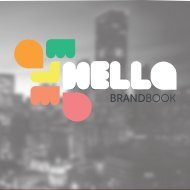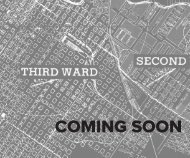final
You also want an ePaper? Increase the reach of your titles
YUMPU automatically turns print PDFs into web optimized ePapers that Google loves.
ed a kind of museum that is shaped and maintained by cultural<br />
practices. Art actions here are idiosyncratic, unique to their locality,<br />
and relate directly to the place they occur within rather<br />
than to the place where they are housed (as is the case in a<br />
typical art museum setting). In the Third Ward, “cultural practices”<br />
are those everyday actions valued as art, whether they<br />
are culinary, sculptural, or celebratory. Similarly, Lowe’s art is<br />
a cultural practice, to give it a new moniker. One that is both<br />
reflective and active in engaging the arts with daily life.<br />
Often discussed as one of the most successful of emergent “social<br />
art practices,” PRH confronts the critique of social art’s<br />
function. In an article for the International Socialist Review,<br />
Ben Davis asks, “Is this strand of art a starting point for addressing<br />
social problems, or a distraction that keeps us from seeing<br />
their true extent?” One response is that such art is not necessarily<br />
about solving social problems. Instead of asking how art<br />
can solve a housing crisis, a drug war, or a homeless problem,<br />
artists should address a different question: how can art validate<br />
and encourage people to define themselves in the world? Art<br />
can be a vehicle for empowerment outside the boundaries of<br />
bureaucratic malaise. PRH’s foray into CDC (Community Development<br />
Corporation) housing, for example, emerged from<br />
Lowe’s recognition of a need for local housing and the idea that<br />
as an art institution, PRH could work with a traditional institution<br />
like Rice University to develop housing on PRH property.<br />
The addition of new housing to the PRH site bolstered the social<br />
nature of the art institution. But as the CDC expanded its<br />
housing development to other sites not contiguous with PRH,<br />
Lowe decided to separate the CDC from the PRH art institution,<br />
a move that sheds light on the limits of agency in social art<br />
practices. Development becomes less about art and more about<br />
business and finance. The “power of art” in this context is diminished<br />
when it becomes subservient to other imperatives.<br />
Gentrification is a real concern in places like the Third Ward,<br />
and artists are often a major harbinger of the arrival of new<br />
wealthier residents. PRH, however, demonstrates how artists<br />
can be part of what is already there. Artists didn’t discover row<br />
houses and Rick Lowe didn’t discover the Third Ward. He instead<br />
saw people living in a place and decided to become part<br />
of their lives.<br />
A cultural art practice, unlike a social art practice, is about time<br />
and investment. Many social art practices provide commentary<br />
on social issues, but they engage with place as the setting for<br />
the art, not as the site of an intended physical transformation.<br />
Take, for example, Suzanne Lacy’s orchestrated works; they are<br />
powerful events that leave a lasting memory—and lead to possible<br />
consequent actions—but they are somewhat ambiguous<br />
in terms of site transformation. In contrast, the culture of Project<br />
Row Houses demands that engagement be constant and on-




